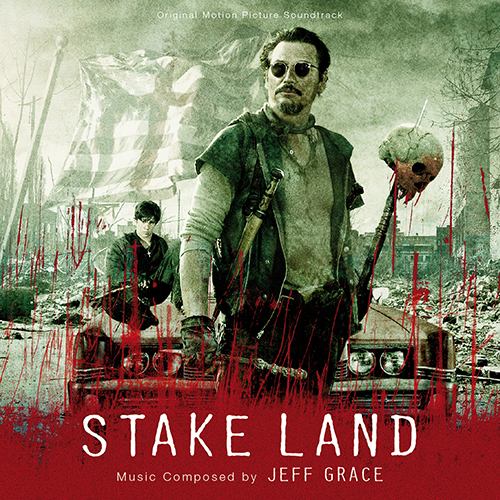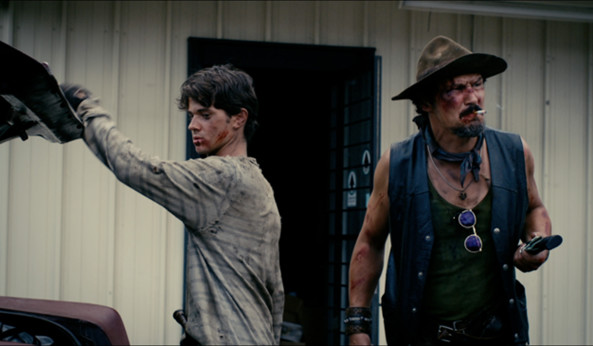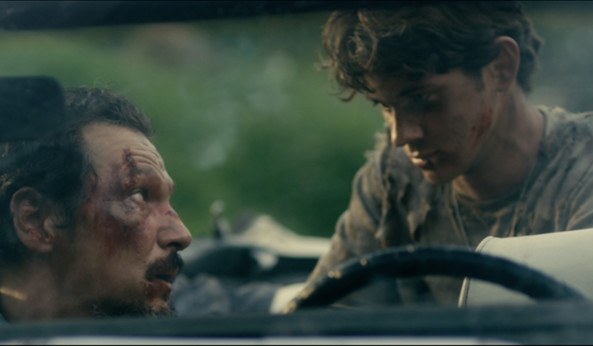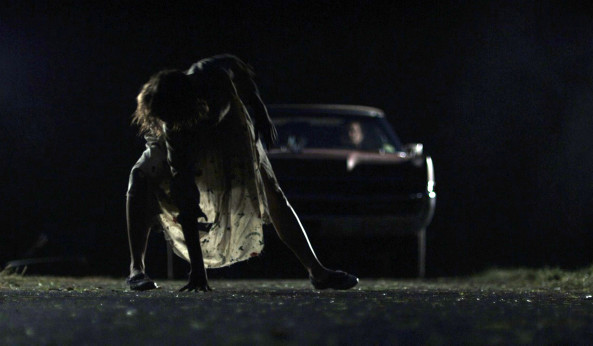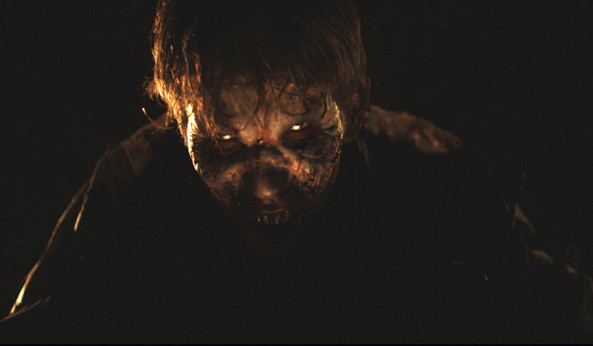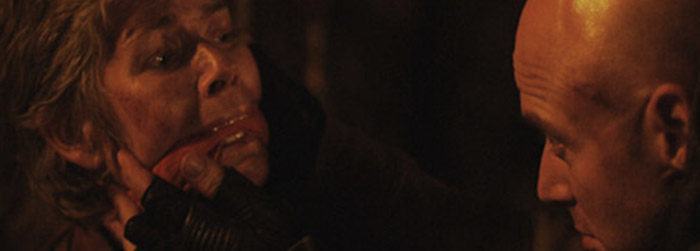The American Horror Film of the Year
Todd Brown TWITCH FILMNEW YORK TIMES
Jeannette Catsoulis
“It ain’t a normal world,” says Martin (Connor Paolo) at the beginning of “Stake Land,” and, really, what postapocalyptic-vampire-western world ever is? That said, this unusually taut sophomore feature from Jim Mickle is more abnormal than most in that its creatures are capable not only of evolving but also of embracing religious fanaticism.
Essentially “The Road” on supernatural steroids, this unrelentingly grim tale takes to the tarmac with Martin — orphaned by a worldwide plague of vamp-zombie hybrids — and a taciturn companion known only as Mister (Nick Damici). As they head for rumored haven in the biblically named New Eden, skulls are hammered, nuns rescued (hello, Kelly McGillis!) and cannibals squished in Mister’s continuing attempts to train his young protégé in the fine art of stakecraft. Given the ferocity and endurance of the special-effects team’s creations, Martin has his work cut out.
Yet the film’s bloodsucking undead are pussycats compared with the Brotherhood, a coven of fundamentalist terrorists led by a sadistic, ovoid-headed loon (Michael Cerveris). Their presence lampoons extremists who view every disaster as a signal for end-of-days rejoicing and holds our attention through occasional narrative doldrums. Even when the story flags, however, Ryan Samul’s cinematography and Jeff Grace’s score pick up the slack, smoothly maintaining an unstable atmosphere of lurking horror.
Partially dispelling the stench of misanthropy that clings to most zombie movies, “Stake Land” offers moments of ethical pause that suggest some empathy for the infected — before turning them into drooling weapons and tossing them from a plane. Oh well.
STAKE LAND
Opens on Friday in Manhattan.
Directed by Jim Mickle; written by Nick Damici and Mr. Mickle; director of photography, Ryan Samul; music by Jeff Grace; production design by Daniel Kersting; costumes by Elizabeth Fastola; produced by Adam Folk, Brent Kunkle, Peter Phok and Larry Fessenden; released by IFC Midnight and Dark Sky Films. At the IFC Center, 323 Avenue of the Americas, at Third Street, Greenwich Village. Running time: 1 hour 36 minutes. This film is not rated.
WITH: Nick Damici (Mister), Connor Paolo (Martin), Kelly McGillis (Sister), Danielle Harris (Belle), Sean Nelson (Willie) and Michael Cerveris (Jebedia).
Top | Link
THE NEW YORKER
Jim Mickle 2011
Fans of Cormac McCarthy’s “The Road” will find much to enjoy in this sombre and nerve-wracking postapocalyptic horror film, directed and co-written by Jim Mickle. The story is centered on a Southern teen-age boy (Connor Paolo) who, after his family is killed by blood-sucking flesh eaters, is taken under the wing of a man called Mister (the co-writer Nick Damici) and learns the art of a good staking. Together they travel north in search of a safe haven. The performances are terrific; Damici has a craggy, commanding Charles Bronson-like authority, and Paolo, though sensitive, leaves his character open to tougher, more violent possibilities. The mayhem is beautifully composed and, as the pair travels through small towns filled with survivors and with marauding bands of killers, the film’s rural, disembowelled landscape turns nature itself into an enemy.
Top | Link
NEW YORK OBSERVER
Rex Reed
If you grew up on classic horror movies, you must be as baffled and appalled as I am by the recent avalanche of films, TV shows and airplane-terminal beach books about lovesick vampires turning into goony-eyed romance-novel sweethearts who buy their daily blood supply at Walgreens. To Hillary Clinton, it may take a village, but to what remains of the American countryside gone to hell in Stake Land, all it takes is a stake through the heart. Despite the violence and mayhem, I actually liked this one. It’s harrowing; even the clichés are bloodcurdling; and it takes vampires out of the dime-store paperback genre and puts them back where they belong–in your nightmares, and at your throat.
In this grim, cynical view of a postapocalyptic world, a boy named Martin (Connor Paolo, from the TV series Gossip Girl) teams up with a grizzled vampire hunter called, simply, “Mister” (Nick Damici, who co-wrote the screenplay with director Jim Mickle). Together, they form a surrogate father-son relationship, traveling across the American heartland only in the sunlight daytime hours, heading north toward Canada, where monsters fear to go. Passing signs that preach “And God tore the world asunder,” avoiding cities and sticking to the back roads, where corpses hang from burned trees in nooses, they try to kill as many “vamps” as possible and stay alive in a landscape of horror. Sometimes they find live humans, trying to survive. But when news arrives that the president is dead and Washington, D.C., has been destroyed, everything looks hopeless. “We were all orphans, looking for something to hold on to,” says the boy, who doubles as narrator. Things get bleaker.
If the vampires don’t get them, the cannibals might. So the monsters in Stake Land are a cross between blood-sucking Draculas and the flesh-eating zombies from Night of the Living Dead, and they’re all pissed off, big time. Like the man and boy in The Road, Martin and Mister wander upon roadside campgrounds turned into charnel houses and villages that have been torched. (Call it Cormac McCarthy with fangs.) Miraculously, they also bond with a small band of followers; together, they form a new kind of family unit, one that includes a black Marine, a pregnant girl and, making her first screen appearance in a decade, Kelly McGillis as a nun they rescue from a gang rape. They are all pursued by a venomous fundamentalist militia called The Brethren who blame the vampire plague on the Lord. Directed with an intensity that reaches a fever pitch, the film also takes a moment or two for some gallows humor–Mister fights off a howling gang of the undead with his hands tied, and later, Martin stakes a vampire wearing a Santa Claus suit.
There isn’t much dialogue, and most of the 98-minute running time is devoted to locking in one terrifyingly gothic encounter after another, but the characters are well defined, and director Mickle (who made the zombie-rat thriller Mulberry Street) makes every dime of his micro-budget count. Stake Land is original and entertaining enough to keep the audience focused, even though a lot of things go unexplained. What caused the vampire explosion in the first place? How did they get that way? Where on earth do the protagonists keep finding gasoline, and what do they do for money? I don’t blame the frenzied vampires when they refuse to cross the border and move to Canada. Wouldn’t you?
Top | Link
THE VILLAGE VOICE
Karina Longworth Apr 20 2011
Post-apocalypse slow-burner Stake Land, produced by Larry Fessenden, is Jim Mickleand Nick Damici’s follow-up to the killer-rats-infest-the-LES flick Mulberry Street. It’s an ambitious hybrid, grafting the ethereal, landscape-driven, light-infused beauty and naïf narration associated with Terrence Malick onto a tale in which struggle against supernatural forces is just one challenge of coming of age—a trope that has become inescapably trendy of late, but hasn’t had such a sense of balance between the fantastic and the organic since the heyday of Joss Whedon. Seventeen-year-old Martin (Connor Paolo) is orphaned by killer vampires and saved by badass drifter Mister (Damici). The pair head west toward a supposed promised land, across a convincingly devastated landscape (the art direction complements actual landmarks of decaying Americana), fighting bloodsuckers, and the neo-Aryan nuts who worship them (and even flew planes full of vamps into national landmarks). How it came to pass that “they” took over is never fully explained: We only know that at some indeterminate point, trouble started and didn’t stop, and now those left alive are adapting by any means necessary. The narration is sometimes cloying, the Mother Mary metaphors are pumped hard, and the aesthetics can verge on self-parody (Martin’s vamp-dusting training reliably takes place at magic hour). But it’s thick with a distinct mood—the sadness and exhilaration of having nothing left to lose—and the characters, in their desperation and drive, feel real. Fessenden may be producing the best brains-before-blood horror in North America today.
Top | Link
SALON
Andrew O'Hehir
Pick of the week: “Stake Land” offers a juicy saga of vampire-killers in an almost-recognizable America
It’s not like the world needs a great deal more vampire-and-zombie-apocalypse entertainment, but it’s good to see practitioners of the craft occasionally keep it real. By “real,” of course, I mean an utterly subjective standard that may not be meaningful to that many other people: gory and tense, but not drenched in self-awareness or “quotations”; a focus on characters and setting rather than splatter; a noirish, boyish, comic-book spirit; the loving evocation — but not quite imitation — of low-budget 1970s and ’80s end-of-the-world movies, from “Escape From New York” to “A Boy and His Dog” to the “Mad Max” series.
It’s in that spirit that I suggest “Stake Land,” a satisfying genre exercise from indie-horror auteur Jim Mickle (“Mulberry Street”), the pride of Pottstown, Pa., and producer Larry Fessenden, who has almost single-handedly sparked a revival of low-budget, New York-based independent cinema. Now, it’s perfectly true that the story of “Stake Land” is strikingly similar to that of “The Road,” the post-apocalyptic Cormac McCarthy novel that reached the screen last year by way of Aussie filmmaker John Hillcoat (except with that film’s portentous, minimalist allegory replaced with an actual story). But you might just as well say that it resembles “The Searchers” or “The Adventures of Huckleberry Finn” or “Of Mice and Men,” in that it’s an archetypal American yarn about two guys on the road through an unforgiving landscape.
Maybe those other stories don’t have ravening hordes of undead “vamps,” “scamps” and “berserkers” in them, but the focus of “Stake Land,” as in the best horror flicks, is more on the human characters than the monsters in any case. Our soulful teen hero and narrator is Martin (Connor Paolo, best known as Eric in TV’s “Gossip Girl”), who is of course wise beyond his years — seeing your parents and infant sibling eaten by half-human ghouls will do that. Martin is saved at the last moment by a grizzled vampire-hunter known only as Mister (Nick Damici, who co-wrote the script with Mickle), who is a little bit Clint Eastwood’s Man With No Name, a little bit David Carradine’s Kaine from “Kung Fu” and all stake-through-the-heart, canine-tooth-collectin’ badass. The relationship between the two is both tense and tender, the push-pull between a kid who still imagines all kinds of possibilities for himself and the world and a violent, bitter man trying to extract some shreds of meaning from a life he probably suspects is guttering out like a spent candle.
This ersatz father-son combo heads out on the open road in a fortified muscle car, across a desolate but pretty much recognizable American landscape that’s probably Mickle’s greatest creation. He understands that real horror is a plot-dense medium like fantasy and sci-fi, not just a sequence of money shots like porn or a Michael Bay-era action movie. There’s not too much flat-footed exposition in “Stake Land,” but we learn the basics: After an unexplained plague decimated the population, rendering much of it into feral flesh-eaters and bloodsuckers, the federal government has collapsed. America is now more like a bunch of quasi-feudal, heavily armed fiefdoms than a nation, but even that faint vestige of civilized life is under attack from a millennial Christian sect called the Brotherhood, which uses truckloads of captured undead as low-tech weapons of mass destruction. They evidently believe the zombie-vampire plague was sent by God to destroy the evil government and accelerate the end-times — and there’s a chilling throwaway line that makes clear Mickle and Damici see the Brotherhood as the Tea Party gone fatally insane (if that’s not redundant).
Mister and Martin are trying to find a rumored zombie-free enclave called New Eden, somewhere north of the Canadian border, but whether that even exists or what it might be like is the subject of all sorts of troubling rumor. (Mickle has cited Terrence Malick’s “Badlands” as an influence, and he understands how close this kind of horror movie brushes against many other genres.) Along the way they save a missionary nun from rapists — and it’s one-time Hollywood star Kelly McGillis, in her first movie role in several years — before losing her again when they’re taken captive by a Brotherhood band headed by the bald, sadistic Jebedia (TV and stage veteran Michael Cerveris). Other people ride along, including a pregnant country singer (Danielle Harris) and an African-American ex-Marine (Sean Nelson), and the terrific supporting cast also includes producer Fessenden as a laconic bartender.
“Stake Land” isn’t some dazzling, revisionist reinvention of horror or anything. But it’s so well done, and has such respect for the genre, its fans and its traditions, that it far outstrips the recent competition, whether big budget or small. Decent scares and genuinely gruesome special effects, a gritty and ominous drive-in aesthetic (provided by cinematographer Ryan Samul and production designer Daniel Kersting) and a deceptively casual portrait of an almost-believable America in terminal decline — what more do you want? Horror fans will celebrate “Stake Land,” and future horror-film directors should go to school on it. The flame is still burning — and it keeps the undead away, at least for a while.
Top | Link
NATIONAL PUBLIC RADIO
Scott Tobias April 21, 2011
Over the past decade, the movies have obsessed over doomsday scenarios of all kinds — global warming, global cooling, nuclear war, earthquakes, asteroids, aliens, zombies, shortages in water, oil or food, or the inability to scribble down salon appointments on Mayan calendars after Dec. 21, 2012.
The art-horror indie Stake Land adds vampires to that list, but its true novelty comes less from its apocalyptic scenario than from its vision of how America adapts. If we’re the type of culture that has an End of Days fetish — and, clearly, that is the case — then it stands to reason that some stand ready to take advantage should they be among the few to survive.
An odd, ambitious and only partially successful fusion of Terrence Malick poetics and 28 Days Later viscera, Stake Land works best as a skeptical take on Christian rapture fiction — think the Left Behind series, which imagines a pre-Judgment Day period of tribulation in which the righteous war with the forces of the Antichrist. Director Jim Mickle, who co-wrote the script with actor Nick Damici, instead imagines a ravaged landscape where religious charlatans are every bit as dangerous as the feral, relentless, nearly unslayable creatures that feast on the populace. At a time when people are desperately searching for answers, it’s the shameless, power-hungry opportunists who step up to provide them.
Like the naive young narrators in Malick’s Badlands and Days Of Heaven, Stake Land turns to an innocent to set its wistful tone through an ever-present voice-over track. As the film opens, rural teenager Martin (Gossip Girl’s Connor Paolo) has just watched his entire family get slaughtered in a vampire attack, an event that leaves him so numb with grief that he can’t process it. Martin owes his life to the intervention of a vampire hunter, played by Damici, who speaks in grim monotone and goes by the name of “Mister.”
With Mister tutoring Martin on the finer points of slaying and survival, the two take a treacherous route north to a rumored Canadian idyll known as New Eden. Along the way, they take on a few travelers, including a pregnant bar singer (Danielle Harris) and a nun (Kelly McGillis) whose faith has been shaken by a mass exodus of followers. Mister has his primitive but effective ways of dealing with the vampires, but he faces a stiffer challenge from The Brethren, a fundamentalist cult whose leader (Michael Cerveris) commands a growing militia.
Mister (Nick Damici), an unhinged vampire hunter, saves Martin and teaches him how to survive in the post-apocalyptic wasteland.i
Mister (Nick Damici), an unhinged vampire hunter, saves Martin and teaches him how to survive in the post-apocalyptic wasteland.
IFC Films
Substitute zombies for vampires, and Stake Land has a lot in common with last year’s Zombieland: two men in a convertible — one a nomadic warrior who battles the undead, the other his uncertain younger prodigy — who abide by their own quirky set of rules. Tonally, however, Stake Land is closer to the ash- and dust-choked nightmares of The Road or Mad Max, with the heroes stranded in a world that’s barren and nearly dead. On a very modest budget, Mickle converts rural outposts into makeshift villages with their own currency and trade, and creates vampires whose decomposing visages seem to reflect the breakdown in society itself.
Only when it reaches too explicitly for profundity does Stake Land fall short, particularly in narration that says too much, suggests too little and doesn’t justify its omnipresence. Martin has neither an inner life so complicated that it can’t be read nor a perspective so unique and lyrical that it’s worth airing out. At times, Mickle fails to trust his ability to get across ideas without having them lacquered in art-house poetry. His vampire apocalypse has been classed up to a fault.
Yet Stake Land belongs to a promising subset of contemporary horror films — including several by its co-producer Larry Fessenden, who directs socially conscious horror, and its production company Dark Sky Films, which was responsible for the superb retro-’80s thriller The House Of The Devil — that seem determined to press the genre beyond mere slice-and-dice. Though it has plenty of shocks, the film creates a wasteland that would be compellingly deranged even without vampires pressing insistently at every border. Horror is just the half of it.
Top | Link
AIN'T IT COOL NEWS
Anton Sirius Sept. 19, 2010
Given the rash of vampire movies and post-apocalyptic movies that have seen the light of day recently, it was probably inevitable that we’d get something like Stakeland. Throw enough Book of Elis and 30 Days of Nights and I Am Legends into the collective unconscious and eventually a post-apocalyptic vampire road movie was going to spring forth from somebody’s brow.
Which is why it’s incredible, not that Stakeland exists at all, but that it’s so damn good.
The plot is beautifully stripped down. Vampirism has swept the globe and destroyed civilization; wherever humans gather in numbers the vamps will follow, forcing survivors to stay isolated. In the States, a battle-scarred hunter known only as Mister rescues a young boy, Martin, after the rest of his family gets eated, and together they start a journey north to the rumored safe haven of New Eden.
It’s impossible to over-emphasize how perfectly that rescue scene sets the tone for what will follow. Nothing says that the usual rules of decorum have been tossed out the window better than watching a vampire squat up in the rafters, suck Martin’s infant sister dry and toss her aside like she was a piece of fruit. It’s not the most gruesome thing you’ll see in a horror movie this year, but it might just be the bleakest, and finding the right level of bleakness is the single most important job any post-apocalyptic film has. Stakeland finds it inside the first five minutes of the movie, and never lets it go.
As Martin and Mister head north, they find that the bloodsuckers aren’t the only predators they need to worry about. A Christian cult owns the highways, preaching that the vamps are God’s curse upon unbelievers, and the Brotherhood and their deranged leader Jebediah prove to be far more dangerous than anything with fangs.
One of the big things that sets Stakeland apart is the care that’s taken with the world around Mister and Martin. The cause of the vampiric outbreak is never explained, but its effects on civilization are spelled out in meticulous detail. A Marine they travel with for a while, when asked who won the war in the Middle East, snaps back “No one. There was nobody left to fight it.” Basic pharmaceuticals become valuable currency. And while the vampires themselves are fairly standard-issue mindless, blood-crazed, tough as hell killing machines, the implications of that form of vampirism get fully explored, both by Mister in his efforts to trap them, and by the Brotherhood’s use of them as weapons. I won’t spoil the movie’s brilliant, jaw-dropping set piece, but it’s a thing of pure genius in its execution and its understanding of how evil and inventive humans can be.
Stakeland is inevitably going to get compared to two films in particular: Zombieland, due only to the similar titles and the fact that humans are an endangered species in each, and Hillcoat’s The Road. The first is just unfortunate, as Stakeland is deadly serious in ways Zombieland couldn’t be — there’s no Bill Murray cameo here (oops, spoiler!), no silly graphics displaying the rules to the audience. The two are different genres entirely, really. But when it comes to the latter, I’d say that not only does Stakeland hold its own against The Road, it’s actually the superior film.
It all comes back to that right mix of bleakness and hope. Stakeland doesn’t have what you could call a happy ending, but it does give you that real possibility that there may be a future after all. And in a world as dark as this one, just that little glimmer of light through the black is all you need to get you through.
Top | Link
VARIETY
Alissa Simon
Set in a post-apocalyptic world midway between “Zombieland” and “The Road,” the genre-enlivening “Stake Land” is a highly satisfying low-budget horror-thriller from helmer/co-writer Jim Mickle. Making strong use of Western iconography and conventions, this road movie follows a man and a boy seeking the perhaps apocryphal safety of New Eden, fending off ravenous vampires as well as crazed fundamentalists along the way. Highly cinematic, pitch-perfect yarn should take a sizable bite out of the genre box office during its 2011 release from boutique horror label Dark Sky Films, with toothsome ancillary to follow.
Opening as an epidemic of vampirism has brought down the U.S. government and thrust society into chaos, the film gets off to a bloody start with the murder of a suburban family by flesh-chomping creatures who resemble the zombies from George Romero’s “Night of the Living Dead.” Teen protagonist Martin (“Gossip Girl’s” Connor Paolo) is rescued from the carnage by grizzled vampire hunter Mister (co-writer Nick Damici) and trained in the life-or-death art of staking a bloodsucker.
As the two head north in a vintage convertible, they pass through striking deserted landscapes and rural “lockdowns” (vamp-free zones), depicted as Western frontier towns complete with archetypal doctors, barbers, brothels and saloons. Along the way, they acquire assorted traveling companions — nun Sister Anna (an almost unrecognizable Kelly McGillis), pregnant Belle (Danielle Harris) and Marine Willie (Sean Nelson) — and tangle with the Brethren, a Christian militia led by the deranged Jebedia (Michael Cerveris).
While Romero’s work is among the pic’s discernible influences, it also contains echoes of cult films from “The Last Man on Earth” to “The Road Warrior.” Yet more than anything, it plays like a latter-day Western, with vampires in the place of Native Americans.
Genre-savvy co-scripters Mickle and Damici are clearly conscious of the similarities between apocalyptic stories and oaters, and find inspired ways to reinforce the connection. Moreover, as in their well-received first feature, “Mulberry Street,” they incorporate social commentary without being too insistent; it’s not difficult to think of the militant evangelical groups of our times evolving into the Brethren.
Taking on a larger canvas than that of “Mulberry Street,” Mickle rises to the challenge, confirming his reputation as an emerging horror auteur. Creating character with very little dialogue, he moves away from splatter and gross-out humor to create something more mythic. Apart from the evilly eloquent Cerveris, the main thesps adopt a less-is-more style that comes across as quietly heroic. Landing relatively little screen time, the decomposing, undead creatures seem more akin to the movie zombies of the past than the sleek, sexy vampires in vogue today.
With the 27-day shoot spread over three seasons and varied natural landscapes, the atmospheric lensing by Ryan Samul on the Red One camera achieves impressive texture. Also standing out among the strong craft credits is Jeff Grace’s evocative score, which incorporates spirituals and traditional folk tunes.Slightly cheesy visual effects were rendered on commercial software Adobe After FX.
Film won the People’s Choice Award in the Midnight Madness section.
Top | Link
TWITCH
Grady Hendrix April 22, 2011
“And then all that goodness was ruined by Christian crazies dropping vampires out of the sky.”
Any movie that has a line like that in it, and that means it literally, is my kind of movie. Fundamentally nuts, Jim Mickle’s STAKE LAND is essentially a movie about people running away from vampires. And that’s it. But it explores the idea of people running away from vampires so thoroughly that it blows away lots of the ostensibly more ambitious films also playing at the Toronto Film Festival simply through the purity of its ambitions and the rough, redneck energy of its filmmaking. This is a film that is totally comfortable with being a b-list, genre flick, a straight-up shot of exploitation moonshine with no chaser and as such it is the best movie it could possibly be. Just think of Jim Mickle as an American Neil Marshall (The Descent, Dog Soldiers) and you’ll have an idea of what you’re in for.
Mickle’s previous film, MULBERRY STREET, was a stripped-down end-of-the-world-because-we’re-all-getting-eaten-by-giant-honking-rats flick shot on a shoestring in one location. A lot of people thought it was so clench-jawed and fuel efficient because Mickle made if for $3.45 plus a Quiznos half off coupon. But actually, STAKE LAND goes to show that Mickle doesn’t know how to make a movie any other way. He directs the way a three year old drives: he jams the pedal to the metal and plows through anything in his way.
The story follows Martin (Gossip Girl’s Connor Paolo) who teams up with Mister (Nick Damici) to try to get away from a vampire plague sweeping the nation. Mister is the Punisher of the vampire world: he likes killing vampires because it gives his life purpose. And because it’s cool. The two of them take off through a post-apocalyptic America that feels like a Lynyrd Skynyrd song: all Harley hogs and country bars and cowboy boots and Bowie knives. Because of all the lousy, stinking vampires the survivors of the plague have either become giant assholes, turned to religion or started having yard sales. This is very depressing. Mister and Martin on the other hand have responded to the plague by packing a bunch of weapons into a muscle car and wiping out vamps with stake-fu. Now ask yourself: which are the real Americans.
STAKE LAND is basically the story of Martin and Mister’s Amazing Vampire Killing Road Show with stops for Kelly McGillis (playing a nun) and some other interludes, most motivated by the fact that Martin’s peach fuzz charms are like catnip to the ladies, vampire and nonvampire alike, who haven’t seen a non-bearded and non-stinky man in some time. The gore flows fast, free and wet, but the movie’s greatest special effect is Nick Damici, who was also the star of Mickle’s MULBERRY STREET. Damici has all the craggy authority and tight-lipped intensity that it takes some actors a lifetime of being left out in the rain overnight to achieve, and he doles it out in heaping portions. There hasn’t been a man this macho in a horror movie in a long time, and sneaking into screenings of STAKE LAND is going to jump start puberty in 12-year-old boys everywhere.
You can project a lot onto STAKE LAND, the same way that people go back and read context and meaning into Howard Hawks’s films or Walter Hill’s. But, like them, Mickle is just happy and unashamed to be making a genre picture with no pretensions to Deep Meaning. One could say that the fall of George Romero happened because he started telling people what his movies were about rather than just making them. Mickle hasn’t fallen into that trap. As of now, he’s just making movies and if you want to read theory onto them, that’s your business not his. But in the meantime, if you want to see people run away from vampires, and occasionally skewer, slice, chop and mutilate them, then you’re in good hands with STAKE LAND.
Top | Link
MISTER HORROR.COM
Last night’s Midnight Madness line for Stake Land was the shortest I’ve been in all week, but the Ryerson was still full enough to be rowdy. The crowd was treated to the best Midnight Madness film of the year, and the first that could be considered truly great. Director Jim Mickle and Larry Fessenden’s Glass Eye Pix have made their best film so far.
The film opens with young Martin (Connor Paolo) and his family preparing their car for what they expect to be a long journey. Their radio warns people not to travel at night and to stay indoors if possible. Martin’s dog runs out of the barn and into the night, and Martin chases after him. Martin trips and falls as the door to the barn slams shut and his parents scream. A man known only as Mister (Nick Damici) silences Martin and keeps him from rushing into the barn. The two sneak in to find mother dead, father seriously wounded, and a vampire snacking on Martin’s baby sibling. Mister dispatches the vampire with Martin’s help and then puts the father out of his misery.
From here we follow Mister and Martin’s journey as they travel north and away from the cities. Mister trains Martin in survival skills and stake-oriented tai chi. As a post-apocalyptic road movie, the film invites comparisons to Zombieland or The Road, but the tone here is completely different. Stake Land is more western than anything else, as the protagonists move between increasingly remote outposts, picking up traveling companions and fighting off savage vampires and an outlaw religious cult as they attempt to reach New Eden, which may or may not be the safe haven they are hoping for.
The Brotherhood, as the cult is known, is nearly as terrifying as the vampires themselves. The group believes that God has sent the vampires to cleanse the land, and they happily leave Mister to be consumed. We later hear stories of Brotherhood members crashing trucks full of vampires into outposts and flying planes full of them into cities. This plays out in a terrifying long take of vampires being dropped from helicopters on a peaceful outpost’s dance party.
The Brotherhood’s leader Jebedia Loven (Michael Cerveris) is particularly frightening in his calm portrayal of a man who has filled the vacuum of power with horrifying results. Much of the second half of the film involves Mister and his gang trying to evade Jebidia, and the film keeps things fresh and surprising through to the end.
Especially delightful are supporting performances from Kelly McGillis as a nun saved from would-be rapists by Mister and Danielle Harris as a pregnant girl who joins in on the trip.
Stake Land is a fantastically scary and heartbreaking film that never betrays its low-budget roots. Hopefully, this film will get the exposure it deserves.
Top
THE FILM BUFF BLOG
The Coelacanth September 9, 2010
So, this year’s version of Midnight Madness is winding down, but one of the films that I’d been most looking forward to was screened last night, and lo and behold, did it ever deliver. Jim Mickle’s Stake Land shows us an America perhaps in the not-too-distant future wherein vampires have begun to dominate, and society has essentially been splintered into small bands of survivors, with two clear cut camps: religious fundamentalists and the sane. In these days of Tea Party hysteria, this is all too uncomfortably familiar. More a road movie than a vamp flick, Stake Land reveals that, in an age of fanaticism and intolerance, vampires are the least of our worries.
The story has a man (“Mister”) and a boy (“Martin”)joining forces in order to get to a safe haven in the north known as New Eden. However, it is unclear if this refuge will even provide solace, as the boy is warned by a store clerk that they’ll need to watch out for the cannibals one they arrive there. Along the way, Mister and Martin pick up a ragtag band of survivors, whose only link is that they share a respect for human life regardless of race or creed.
All of the actors, to a person, do a fantastic job of creating realistic characterizations out of what could very easily have been caricatures. Kelly McGillis’ nun, “Sister”, is particularly affecting, for even though she wears the cloth, she is not so lost in fundamentalist beliefs or irrationality to realize survival trumps all when belief and urgent pragmatism clash. Nick Damici, who wrote the script for Stake Land (as well as Mickle’s previous film, the wonderfully grimy and similarly humane Mulberry Street), plays Mister, a brooding antihero who softens over the course of the film, and becomes more and more compassionate, learning that looking out for number one may keep you alive, but it will ultimately have the more damaging effect of total alienation. Martin doesn’t have much to say, but provides the voice-over narration that nudges the story along at an easy pace. Sean Nelson, Bonnie Dennison, Danielle Harris, and especially Michael Cerveris as Jebedia Loven, the personification of the idea of Christian Fundamentalism taken to a terrifying extreme, all contribute solid work in slightly smaller roles.
The pacing of the film needs mention, as it is neither fast nor slow, but sort of flows like a languid river, free and easy, never slowing or hastening, and always staying the course. The whole thing felt very natural, very real, and even tangents in the plot acted more like swirling eddies rather than highway off-ramps, deviating for a brief moment of pause before once more giving in to the pull of the water. In fact the whole film has a very naturalistic feel. Kris mentioned before the film that he had been speaking with one of the MM programmers and was told that Stake Land was like if Terrence Malick had shot a vampire film. That idea stuck in my mind as I watched the film, and it is not a poor description at all. Shades of Malick, David Gordon Green’s earlier work, Lance Hammer’s Ballast, and, to come full-circle, fellow Glass Eye Pix alum Kelly Reichardt’s disarmingly real films. In particular, I saw similarities between Stake Land’s characters and the small, touching and very human interactions in Reichardt’s Wendy and Lucy. Pretty deep stuff for just another “vampire” movie.
But that’s just the thing – much like Glass Eye Pix founder, Stake Land producer, and renaissance man extraordinaire Larry Fessenden’s own Habit, Stake Land is really a vampire film in name only, using the vampires as a vehicle to deliver a more important message, a message that perhaps would be criticized as being ham-fisted if it had been wedged into a traditional drama. However, that is an area where horror excels – because of the suspension of disbelief necessary to enjoying the films, an urgent message can be the driving force of a film and not come across forced.
The camera work is stunning in Stake Land, and for every gory money shot, Ryan Samul’s camera lingers over wintry landscapes, reeds, rushes, trees, streams. There is a very familiar sense to these landscapes, the purple and blue hills of the Catskills and beyond, not only because I’ve traveled through them, but because the frosty woods and icy brooks mirror our very own landscape. This familiarization of the setting helps to drive the message home, but I don’t think it would isolate viewers from a different geographical region, though it might make the film a slightly less personal experience.
Jeff Grace contributes a compelling score that draws as much from symphonic work as it does from early Americana and Smithsonian Folkways recordings. Mickle spoke of how the score moved backward in time, almost as if the characters were heading back into pioneer days, evoking old ghosts and decaying dreams. In fact, the film felt very much like we were witnessing a societal de-evolution, a return to primal needs and fears, where survival is not a right, but a privilege, and the score at times reinforces this idea, and at times juxtaposes it, all to great effect. The score acts almost like another narrative device, in the same way that the camera, the narration, and the plot all have us floating down the river at the same pace. The way that all these elements seamlessly mesh and play off each other is nothing short of cinematic excellence, and really showcases the power and importance of the “director”.
Back to Malick – Mickle mentioned in the Q&A that he was heavily influenced by Days of Heaven while shooting Stake Land, and it shows. From the child-like voice-over narration, the score and the naturalistic cinematography – even the small group on the run – Days of Heaven is prevalent here. Which, I suppose, is why Stake Land comes off less like its similarly themed but completely different feeling contemporaneous celluloid peers Zombieland and The Road, and more like, well, a good film, a piece of cinema rather than just a movie. Stake Land, while having the potential to be overly sensationalistic, is expertly helmed by Mickle and the fine production touches by the Glass Eye Pix crew bring it all home.
So I must say bravo, to all involved, and to Colin Geddes for getting this film for the Midnight Madness faithful. Stake Land is certainly an 11th hour contender for my MM top spot. Stake Land is one more addition to the super solid Glass Eye Pix/Scareflix stable, and everyone involved has every right to be very, very proud of what we saw last night.
Also, I want to give a big thanks to Larry, ever the gentleman and awesome guy, for posing for a photo with a huge fan. Those of you who are regular readers of this blog know my respect and admiration for the man, and I’m still a bit star-struck for having been in the presence of one of my cinematic heroes and long-time champion of powerful independent film. And, really, that’s one of the coolest things about MM – unlike the big galas at TIFF, you might find a director or actor in line next to you, waiting with the same anticipation to see something new and exciting. And often you can simply walk up to a legendary director, put your arm around him and smile like a big, dumb kid..
Top | Link
Audiences Everywhere
BECKY BELZILE 12/7/2016
NETFLIX GEM #87: STAKE LAND
Stake Land (2011)
Director: Jim Mickle
Genre: Horror
Dark Sky Films
Synopsis: A vampire hunter and his teen apprentice seek a free life in the wake of a vampiric apocalypse.
Overview: The Walking Dead premiered in 2010 amidst a slew of post-apocalyptic scenarios. As an obvious artistic response to culture, audiences were both enthralled with watching the fall of mankind and inspired by the will to survive they saw onscreen. This isn’t a new phenomenon; since humanity was able to comprehend life and death we’ve been fascinated or afraid of our own end. Unfortunately this theme of apocalyptic horror has become well-worn by now but there is one slice of delightfully bloody pie you may have missed in the buffet of cinema, and that is Stake Land.
Stake Land has achieved cult status for good reason, becoming a fan-favourite for its heart and effort alone. Not only do we get a brutal wasteland to traverse, but one filled with vampires instead of zombies. This movie is like that good trail mix with the chocolate in it. You’ve seen all the parts before. You might not like them all individually, but somehow they work together to create something that’s acceptable to your palate. Even exciting, at times. Stake Land brings you the apocalypse with a scattered remnant of human beings hunted by vampires, a coming-of-age tale with a teenager and a bitter but soft-hearted loner. And what would the apocalypse be without scary religious cults? This one calls themselves the Christian Army of Aryans and they pose an even more powerful threat to our heroes as they venture north to New Eden (Canada, obviously) looking for a better life. These fringe fanatics begin to take control of the country while everyone else just hopes they’ll wake up from the nightmare so they can live their lives normally again. Surprise! It’s all relevant again in 2016!
While Stake Land started out as a hobby for director Jim Mickle and star Nick Damici, something they’d just do on the weekends together when they had spare time, once producer Larry Fessenden caught whiff of the project he saw its potential and encouraged them to make a feature. This resulted in a well-loved low-budget horror film whose cult status only grows. Sometimes it can feel like the world is in a drought of respectable vampires. For those of us who were just too young for Buffy and then too old for Twilight, we had no hand to guide us through our teens and toward quality vampire content immediately relevant to all our fears. Stake Land plays like a graphic novel about vampire hunters without the stylized fights and action, the perfect alternative for people who weren’t fond of the overly-sexy teen vampires who were popular at the time. These vampires are scary, blood soaked and full of rage.
This movie is not without its flaws, but it’s easier to overlook them because the characters are likable even in their canned stock form. Mister (Damici) seems like just another hardass loner who doesn’t talk much and Martin (Connor Paolo) is a super-sensitive teen struggling with, you know, normal teen stuff like how his entire family was killed by vampires. Still for some reason, by the end you really care what happens to them… even though you probably know what’s going to happen to them. For those who find even more enjoyment in it than I did, there are also seven prequel webisodes that give further background information on characters and expands the universe (which feels small at times). If you just can’t get enough, a sequel originally titled The Stakelander (now Stake Land 2) was released on SyFy in October of this year as a direct continuation of the events in Stake Land. If you’d like to revisit the sub-genre and catch something that maybe flew under your radar, give this one a shot on Netflix.
Top | Link
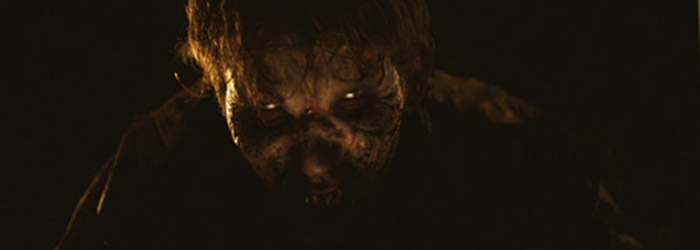
JIM MICKLE , writer/director – Jim Mickle’s debut feature film “Mulberry Street” enjoyed a phenomenal film festival run having screened in 25 major international festivals including Tribeca and South by Southwest. In 2007 the film took home a coveted Audience Award at Fantasia. It later won Best Film as the opening night gala film at the Toronto After Dark Film Festival. Horror bible Fangoria magazine heralded it as “One of the best independent horror features in recent years” and it landed on a number of critics’ “Best of 2007” lists. “Mulberry Street” was acquired theatrically by Lionsgate Films and After Dark Films. Since then he has directed the animated short “One Night in December”Mickle studied film production at NYU, writing and directing three award winning short films. He has worked professionally as a storyboard artist, a lighting technician, a 3D animator, and film editor, gathering over forty credits to his name.He is currently developing an adaptation of Joe R. Lansdale’s classic noir novel “Cold in July”.
LARRY FESSENDEN, producer – Winner of the 1997 Someone to Watch Spirit Award, writer, director and editor of the award-winning art-horror movies HABIT (Nominated for 2 Spirit Awards), WENDIGO and NO TELLING. His most recent film, THE LAST WINTER (Nominated for a 2007 Gotham Award for best ensemble cast), starring Ron Perlman, Connie Britton and James Le Gros, premiered at the 2006 Toronto Film Festival, was distributed by IFC FirstTake. Fessenden recently directed SKIN AND BONES, starring Doug Jones, for NBC TV’s horror anthology show FEAR ITSELF. Fessenden has been a producer on various projects including Kelly Reichardt’s WENDY AND LUCY (nominated for two 2009 Spirit Awards and on over 60 “Top 10 Movie of the Year” lists), Ti West’s THE HOUSE OF THE DEVIL, James McKenney’s SATAN HATES YOU, JT Petty’s BLOOD RED EARTH, Ilya Chaiken’s LIBERTY KID, Douglas Buck’s remake of DePalma’s SISTERS, Jeff Winner’s SATELITE and David Gebroe’s ZOMBIE HONEYMOON. Under his low budget horror banner ScareFlix, Fessenden has produced Ti West’s THE ROOST and TRIGGER MAN, and James Felix McKenney’s THE OFF SEASON and AUTOMATONS, Graham Reznick’s I CAN SEE YOU, Glenn McQuaid’s I SELL THE DEAD starring Dominic Monaghan, Ron Perlman, Angus Scrimm, and Fessenden. I SELL THE DEAD opened the 2009 Slamdance Film Festival where it won awards for best cinematography and best actor (Fessenden).
PETER PHOK, producer – Born in NYC and graduate of the School of Visual Arts started producing with Larry Fessenden’s production company Glass Eye Pix in 2006 and put out Ti West’s TRIGGER MAN, Graham Reznick’s critically lauded I CAN SEE YOU, J.T. Petty’s short, BLOOD RED EARTH, and Glenn McQuaid’s I SELL THE DEAD which was distributed by IFC Films. Phok also produced Ti West’s THE HOUSE OF THE DEVIL which Magnolia Films theatrically distributed. Phok is currently producing new films with Glass Eye Pix and MPI Media Group which include Jim Mickle’s STAKE LAND and Ti West’s THE INNKEEPERS both scheduled to be released in 2011.
BRENT KUNKLE, producer – recently produced a slate of “pulp” horror films with Glass Eye Pix and Dark Sky Films. The pictures include Joe Maggio’s BITTER FEAST, starring James LeGros, Joshua Leonard; Jim Mickle’s STAKE LAND, starring Nick Damici, Michael Cerveris, Danielle Harris and Kelly McGillis; and James Felix McKenney’s HYPOTHERMIA, starring Michael Rooker. Brent began his career assisting at IFP then joined Iridium Entertainment for a short period as a producer’s and development assistant to Marisa Polvino and Michael Corrente (THE DOOR IN THE FLOOR, THE EDUCATION OF CHARLIE BANKS). He later transitioned into film production as production coordinator and music supervisor on LIBERTY KID, winner of Best Picture at the ’07 NY Int’l Latino Film Festival, produced by Mike S. Ryan (PALINDROMES) and Larry Fessenden (HABIT). In 2007 Brent began working full-time for Fessenden at Glass Eye Pix. There he has served as line producer on I SELL THE DEAD starring Dominic Monaghan (LOST) and Ron Perlman (HELLBOY), production supervisor on Ti West’s THE HOUSE OF THE DEVIL, and production manager on James Felix McKenney’s SATAN HATES YOU. He co-produced JT Petty’s short film BLOOD RED EARTH and produced GRAHAM REZNICK’s 3D short film THE VIEWER.
ADAM FOLK, producer – STAKE LAND marks Adam’s second film collaboration with director Jim Mickle. He also produced Mickle’s acclaimed horror film MULBERRY STREET, which enjoyed a theatrical release as one of After Dark’s 8 Films to Die For in 2007. Since joining Belladonna Productions in 2005, Adam has worked on several films including A GUIDE TO RECOGNIZING YOUR SAINTS, THE CALLER, and THE GOOD GUY. Adam most recently produced the drama COMING UP ROSES starring Bernadette Peters. His next film is the noir thriller COLD IN JULY, based on the Joe R. Lansdale novel, and also directed by Mickle. About Glass Eye Pix Glass Eye Pix (“one of the indie scene’s most productive and longest-running companies” –Filmmaker magazine) is the fiercely independent NYC-based production outfit headed by art horror auteur Larry Fessenden (THE LAST WINTER, WENDIGO, HABIT, NBC’s Fear Itself). Fessenden (winner of the 2009 Golden Hammer Award) has operated the company since 1985, with the mission of supporting individual voices in the arts. The company has produced numerous critically acclaimed films in and out of the horror genre, including 2009’s WENDY AND LUCY (Kelly Reichardt), THE HOUSE OF THE DEVIL (Ti West), SATAN HATES YOU (James McKenney) and 2008’s LIBERTY KID (Ilya Chaiken). Glass Eye Pix’s low budget horror banner, Scareflix, was designed to exploit hungry new talent and inspire resourceful filmmakers to produce quality work through seat-of-the-pants ingenuity. Lean budgeted auteur driven pulp pictures that nurture emerging talents of the genre, Scareflix offer faces both familiar and new in chilling tales that celebrate the diversity of the horror movie– from creature features to tales of psychological dread. Glenn McQuaid’s gently macabre I SELL THE DEAD is the sixth Scareflick in the series that began in 2004 a series already populated with killer bats, Robot wars, ghost stories, psychedelic brain melts, sniper rampages, grave robbers and zombies in the films THE ROOST and TRIGGER MAN (Ti West), THE OFF SEASON and AUTOMATONS (James Felix McKenney), and I CAN SEE YOU and THE VIEWER by Graham Reznick. In 2010 the Scareflix library will se the addition of Joe Maggio’s BITTER FEAST, Jim Mickle’s STAKE LAND and James Felix McKenney’s HYPOTHERMIA.About MPI Media Group The MPI Media Group is a leading distributor, licensor, and producer of films, home entertaiment, historical footage and more. Founded in 1976, Chicago-based MPI Media Group remains one of the largest independent entertainment companies offering a compelling slate of the world’s most respected cinema, documentaries, performances and television series. MPI’s wholly owned subsidiaries include MPI Home Video, Dark Sky Films, and the WPA Film Library programs. In North America, product is released via the company’s subsidiary labels; MPI Home Video and Dark Sky.
About Glass Eye Pix
Glass Eye Pix (“one of the indie scene’s most productive and longest-running companies” –Filmmaker magazine) is the fiercely independent NYC-based production outfit headed by art horror auteur Larry Fessenden (THE LAST WINTER, WENDIGO, HABIT, NBC’s Fear Itself). Fessenden (winner of the 2009 Golden Hammer Award) has operated the company since 1985, with the mission of supporting individual voices in the arts. The company has produced numerous critically acclaimed films in and out of the horror genre, including 2009’s WENDY AND LUCY (Kelly Reichardt), THE HOUSE OF THE DEVIL (Ti West), SATAN HATES YOU (James McKenney) and 2008’s LIBERTY KID (Ilya Chaiken).
Glass Eye Pix’s low budget horror banner, Scareflix, was designed to exploit hungry new talent and inspire resourceful filmmakers to produce quality work through seat-of-the-pants ingenuity. Lean budgeted auteur driven pulp pictures that nurture emerging talents of the genre, Scareflix offer faces both familiar and new in chilling tales that celebrate the diversity of the horror movie– from creature features to tales of psychological dread. Glenn McQuaid’s gently macabre I SELL THE DEAD is the sixth Scareflick in the series that began in 2004 a series already populated with killer bats, Robot wars, ghost stories, psychedelic brain melts, sniper rampages, grave robbers and zombies in the films THE ROOST and TRIGGER MAN (Ti West), THE OFF SEASON and AUTOMATONS (James Felix McKenney), and I CAN SEE YOU and THE VIEWER by Graham Reznick. In 2010 the Scareflix library will se the addition of Joe Maggio’s BITTER FEAST, Jim Mickle’s STAKE LAND and James Felix McKenney’s HYPOTHERMIA.
About MPI Media Group
The MPI Media Group is a leading distributor, licensor, and producer of films, home entertaiment, historical footage and more. Founded in 1976, Chicago-based MPI Media Group remains one of the largest independent entertainment companies offering a compelling slate of the world’s most respected cinema, documentaries, performances and television series. MPI’s wholly owned subsidiaries include MPI Home Video, Dark Sky Films, and the WPA Film Library programs. In North America, product is released via the company’s subsidiary labels; MPI Home Video and Dark Sky.
